TurboGrafx-16
Top 10 Best TurboGrafx-16 Games of All Time!
The TurboGrafx-16 (released in Japan as the PC Engine) was a collaborative effort between Hudson Soft and NEC. The system hit store shelves in 1987 and marked the beginning of the 16-bit era – even though it technically used an 8-bit CPU. The TurboGrafx didn’t make a big impact on consumers in the States, but its Japanese counterpart was a huge success. The PC Engine was considerably more powerful than Nintendo’s Famicom, and the extra horsepower was put to use in a myriad of action games and shoot ’em ups. A steady flow of RPGs and adventure games also contributed to the system’s success. The console outsold Sega’s Mega Drive in Japan and even challenged Nintendo for market supremacy. The system is notable for being the first console to have an optional CD attachment, but this list looks exclusively at titles released on the HuCard format.
10
Bonk’s Revenge
1991
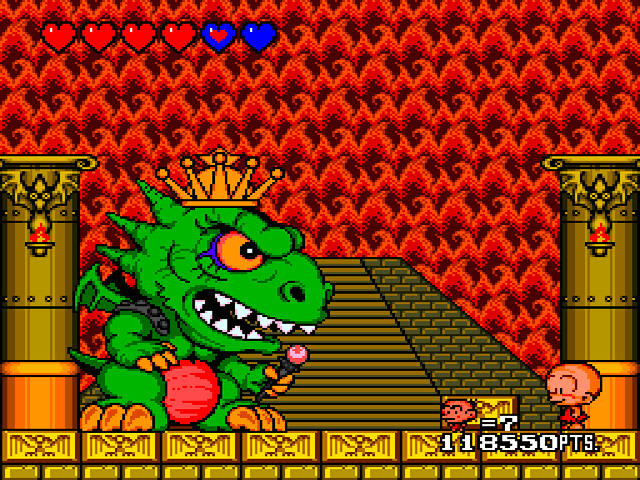
By and large, the target audience for video games in the early ’90s was children. As such, bright and colorful mascot characters were extremely prominent in the industry. Nintendo built an empire around a fat plumber and Sega saw incredible success with a blue hedgehog, so a bald-headed caveman named Bonk wasn’t exactly out of the ordinary. Bonk was originally created as part of a comic strip to help advertise the PC Engine, but the character became so popular that he was given his own game. The bright colors and humorous animations give the Bonk games a lot of personality, and the series also features interesting gameplay mechanics that help define Bonk as a character. Many of the central gameplay elements in Bonk games revolve around the titular character’s oversized cranium. Bonk can head-butt his enemies or cause shockwaves by simply slamming his head into the ground. He can also use his large mouth to grip onto cliff faces and climb up walls. Bonk’s Adventure was well-received upon its release in 1990, but the sequel was even better. The levels were decidedly more complex, the enemies were more plentiful, the graphics were more detailed, the bosses were more impressive, and the Flintstones-inspired humor was even more pronounced. Bonk couldn’t match Mario’s popularity or Sonic’s success, but he was a charming character and his games were unique. As far as platformers go, Bonk’s Revenge is the very best the TurboGrafx has to offer.
9
Dragon’s Curse
1990

Dragon’s Curse is an enhanced version of Wonder Boy III: The Dragon’s Trap. The game is widely considered to be one of the best Sega Master System games of all time, and Dragon’s Curse is even better in many regards. The game retains the central play mechanics from previous Wonder Boy adventures, although there’s a little more emphasis on the exploration this time around. Naturally, players will have the opportunity to find hidden treasures or buy new equipment, but the most interesting aspect about Dragon’s Curse is the various transformations that the player goes through during the course of the game. In addition to his standard human form, the game’s hero will have the opportunity to take the shape of a lion a lizard, a mouse, a piranha, a tiger, or a hawk. Each form has unique abilities that open up the game by enabling the player to reach new areas. For instance, the mouse form can climb walls and ceilings, the piranha form gives the player enhanced swimming capabilities, and the hawk form can soar through the sky! Dragon’s Curse has a couple of significant advantages over the Master System original. The graphics are more colorful, the sprite flicker has been eliminated, and the game has a proper save feature instead of relying exclusively on a clunky password system. Ultimately, Dragon’s Curse is the definitive version of one of the best 8-bit adventure games of all time.
8
R-Type
1989

R-Type was a landmark side-scrolling shooter and one of the first killer apps for the PC Engine. The Master System port was respectable, but the visuals couldn’t come close to the arcade original. The NES, on the other hand, missed out on R-Type entirely even though Nintendo distributed the arcade game in North America. Unless you wanted to fork over $2000 for a Sharp X68000, the PC-Engine was the best way to play the game at home. R-Type was one of the most visually interesting shooters of its day, and it featured environments and enemies that looked like they were pulled form the mind of H.R. Giger. The gameplay was interesting too. The ability to charge up your shot added an element of strategy to a genre that typically challenged players to shoot everything as quickly as possible. The inclusion of an auxiliary companion ship (that could be used as either a shield or a weapon) added even more depth. The game gives players many ways to attack their enemies, but R-Type is unapologetic, unforgiving, and unrelenting. It’s also completely unforgettable. Incidentally, the awesomeness could not be contained on a single HuCard and the game was split up into two parts for the Japanese market. Thankfully, the North American TurboGrafx release contained all eight levels from the arcade original.
7
Ninja Spirit
1990

Released in the arcades in 1988 and on the TurboGrafx two years later, Ninja Spirit features seven straight-forward stages of non-stop ninja action. You’ll have four default weapons at your disposal, including a katana blade, shurikens, bombs, and a wicked sickle and chain. Each of these weapons has its own advantages, and switching between them is effortless. Better yet, each weapon can be upgraded. You’ll also acquire new abilities as you progress – the coolest of which allows you to call upon multiple shadow clones to assist you. This feature was so cool that Tecmo shamelessly “borrowed” it for the Ninja Gaiden series. Where Ninja Spirit really shines is in the fluidity of its combat. You’ll encounter an endless outpouring of enemies and several screen-filling bosses, but you’ll never have to worry about fighting with the controls since your character moves so smoothly. Overshadowed by bigger franchises like Ninja Gaiden and Shinobi, Ninja Spirit was a sleeper that was never as popular as it should have been.
6
Nekketsu High School Dodgeball Club
1990

If you’ve ever stepped foot into a used game store, you’ve probably noticed that nobody cares about sports games. That’s because the overwhelming majority of them suck. The Kunio games were notable exceptions, however, since they emphasized fun over realism. Nekketsu High School Dodgeball Club gained notoriety in the West under the name Super Dodge Ball, but the PC Engine was a Japanese exclusive. This is unfortunate, since it was arguably the best version of the game. The PC Engine port combines elements of the arcade and NES versions, and it adds a ton of new content. The stages and characters look like they were pulled from the arcades, but each player has their own individual stats and power shots like in the NES port. There’s also a brand new quest mode that allows players to join rival teams in an effort to hunt down and expose alien dodge ball players! Dodge ball is a fairly straightforward sport, so I appreciate how each stage in Nekketsu High School Dodgeball Club has its own gimmick. As you travel around the world, you’ll slide around on the Iceland tundra, kick up dust on the African plains, and marvel at real-world landmarks like Mount Fuji and the Statue of Liberty. (I personally enjoy visiting England just to hear the Beatles-inspired background music!) Whether you’re competing against a CPU opponent or another player, Nekketsu High School Dodgeball Club is a blast to play.
5
Military Madness
1989

Military Madness is an engaging turn-based strategy war game with a futuristic setting. It’s remarkably accessible for a strategy game, and it provides a helpful tutorial that teaches you the basics of the grid-based combat within a matter of minutes. With a variety of units at your command, your goal is to either destroy your enemies or infiltrate their base. In order to succeed, you’ll have to properly position your units, take advantage of terrain, and capitalize off experience points earned in battle. The first few levels will help you get the hang of things and give you plenty of opportunities to plan your assaults. By the fourth level, the game will start to kick your ass and force you to change the way you think. There are 32 maps to play through, and it will be necessary to develop smarter strategies as the odds are continuously stacked against you. In addition to a lengthy single-player campaign, the game also features support for two players. Many games in this genre require so much micromanagement that there’s no time to focus on developing a real strategy. Thankfully, Military Madness is not one of these games.
4
Air Zonk
1992
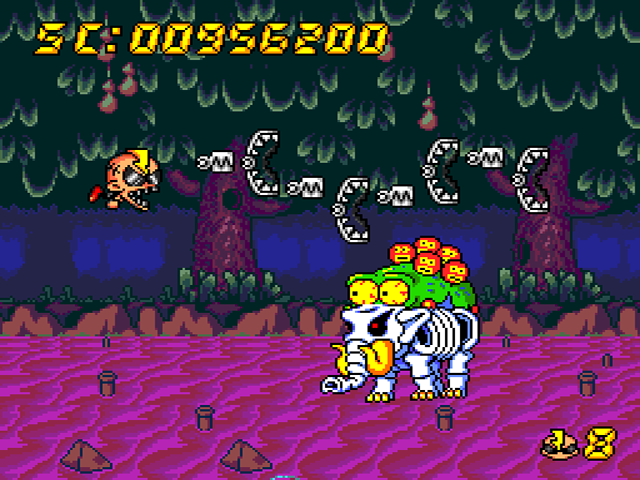
The TurboGrafx had an impressive library of shooters, and the system was home to many era-defining titles. Although games like R-Type and Blazing Lazers deserve credit for codifying the shoot ’em genre, I’ve always favored colorful “cute ’em ups” like Parodius and Fantasy Zone. Air Zonk is a futuristic spinoff of the Bonk series, but it has an identity all of its own. It’s largely defined by its bizarre sense of humor, and I love how ridiculous the enemies are. You’ll encounter everything from robotic dinosaurs to flying trash heaps, and the game never stops surprising you. Against all odds, the weapons are even more outlandish than the enemies. In addition to the usual assortment of missiles and lasers, Zonk will be able to use boxing gloves or novelty alligator teeth as projectiles. He’ll also be able to shrink down in size, which makes it much easier to avoid dangerous situations. There are ten different companions that can accompany Zonk, ranging from a gumball machine to a floating mummy. In certain conditions, Zonk can merge with these friends and gain even more ridiculous abilities. (Merging with his flying cow companion will allow Zonk to bombard his foes with milk bottles!) I often avoid power-ups in shooters once I’ve obtained my desired weapon loadout. Air Zonk creates an environment where I’m always excited to get new weapons even if they’re not necessarily practical or useful. Although Air Zonk provides a reasonable challenge for those who want it, I appreciate how welcoming it is. Many shoot ’em ups feel like they were designed to eat quarters, but Air Zonk is relatively stress-free on lower difficulty settings. Few games capture the spirit of the TurboGrafx like Air Zonk does, and it’s one of those games that seems to get better with age. As an added bonus, it has the best soundtrack to ever grace a TurboChip game.
3
Devil’s Crush
1990

Devil’s Crush is the sequel to Alien Crush and the second in Compile’s series of action/pinball games. The game’s physics are solid, but Devil’s Crush doesn’t limit itself to what would be possible on a real pinball table. Instead of lifeless bumpers, the boards are full of wandering creatures to destroy. In most pinball games, the entire focus is to simply keep the ball in play. In Devil’s Crush, the ball can be used as a weapon against your enemies to rack up points and gain access to bonus areas. The end result is a title that feels as much like a shooter as it does a pinball game. Devil’s Crush was easily one of the best looking games in its genre, and it featured detailed backdrops, smooth animation, and no slowdown. The music was even more impressive, and the haunting soundtrack fit perfectly with the demonic themes. The game was subsequently released on the Genesis as Dragon’s Fury, but I’ve always preferred the TurboGrafx version.
2
Bomberman ’94
1993

There have been hundreds of Bomberman games released on dozens of gaming platforms since the series made its humble debut on the MSX way back in 1983. That said, Bomberman is probably more-closely associated with the PC Engine/TurboGrafx than any other system. The main reason why the series was able to gain so much traction on the console was because of its multiplayer battle mode. Every Bomberman game on the system supports five-player multiplayer battles via the use of a multitap accessory. This feature was crucial to the success of the series and became an expected feature in subsequent Bomberman games. (Evidently, blowing up your friends with bombs is more fun than blowing up mindless creatures in the game’s single-player mode.) Bomberman ’94 was the third, final, and best Bomberman game on the PC Engine and it introduced a number of new concepts to the series. The most significant addition was the debut of rideable kangaroos. Depending on their color, these animals could increase your speed, jump over obstacles, break through obstacles, kick bombs away, or simply taunt opponents with a dance. Bomberman ’94 was the last HuCard game developed and published by Hudson Soft, and it was never released outside of Japan in its original form. However, a version of the game was later released on the Genesis as Mega Bomberman. The Genesis version had inferior graphics and only supported four players instead of five, but it was essentially the same game.
1
Street Fighter II’ Champion Edition
1993

Without question, Street Fighter II is the single most important fighting game of all time. The game revitalized the arcade scene in the early ’90s and its popularity continued on home consoles. Champion Edition on the PC Engine was easily the best console port of Street Fighter II at the time of its release. The game featured several significant improvements over the SNES port of The World Warrior, and the expanded roster of playable characters was greatly appreciated. The graphics closely matched those of the arcade original, and the vibrant colors were comparable to the SNES versions and superior to subsequent Genesis versions. One of the reasons why Champion Edition was able to remain so faithful to the arcade version was due to the size of the game. Standard PC Engine HuCards were no larger than 8 Mb, but Champion Edition was released on a 20 Mb card. The gameplay was solid as well, and a new six button controller was produced specifically for the game. Champion Edition is easily the best fighting game on the PC Engine, and it was pretty amazing that the game was so accurately recreated on what was technically an 8-bit console. It wouldn’t be a stretch to describe Champion Edition as one of the most ambitious PC Engine games of all time.

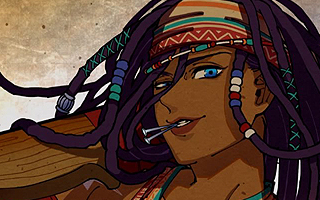
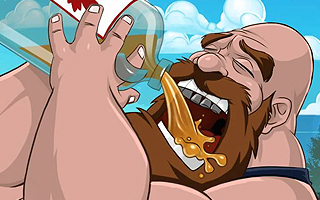
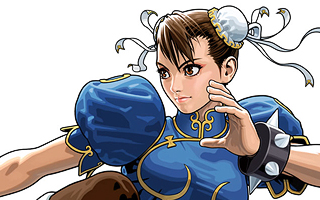
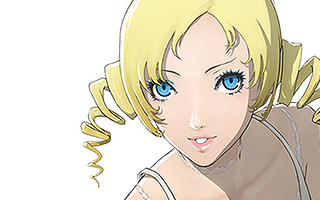
Do you agree with this list? Let us know what you think by leaving a comment below. Your opinion matters!